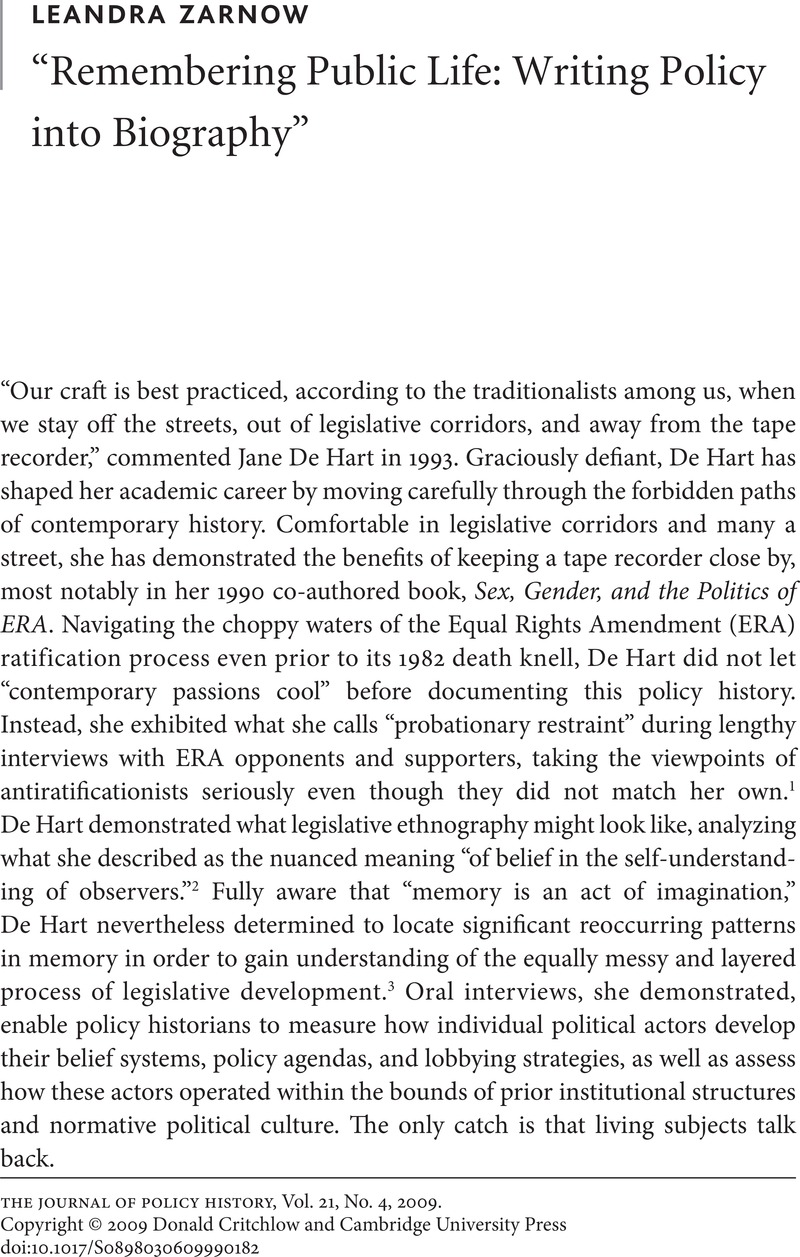No CrossRef data available.
Article contents
“Remembering Public Life: Writing Policy into Biography”
Published online by Cambridge University Press: 01 October 2009
Abstract

- Type
- Forum on The Work of Jane Sherron De Hart
- Information
- Copyright
- Copyright © Donald Critchlow and Cambridge University Press 2009
References
NOTES
1. For all prior quotes in this paragraph, see De Hart, Jane Sherron, “Oral Sources and Contemporary History: Dispelling Old Assumptions,” Journal of American History 80, no. 2 (September 1993): 582–95, 582.CrossRefGoogle Scholar
2. Mathews, Donald G. and De Hart, Jane Sherron, Sex, Gender, and the Politics of ERA (New York, 1990), ix.Google Scholar
3. De Hart, “Oral Sources and Contemporary History,” 591–92.
4. Ibid., 594.
5. Representative explorations of biography are Lepore, Jill, “Historians Who Love Too Much: Reflections on Microhistory and Biography,” Journal of American History 88, no. 1 (June 2001): 129–44CrossRefGoogle Scholar; Kalman, Laura, “The Power of Biography,” Law & Social Inquiry 23, no. 2 (Spring 1998): 479–530CrossRefGoogle Scholar; and “Symposium: National Conference on Judicial Biography,” New York University Law Review 70 (June 1995): 485Google Scholar.
6. Jacobs, Meg and Zelizer, Julian E., “The Democratic Experiment: New Directions in American Political History,” in The Democratic Experiment: New Directions in American Political History, ed. Jacobs, Meg, Zelizer, Julian E., and Novak, William (Princeton, 2003), 1–19 (8).Google Scholar
7. Kalman, Laura, “Law, Politics, and the New Deal(s),” Yale Law Journal 108, no. 8 (June 1999): 2165–2213 (2167).CrossRefGoogle Scholar
8. Reva Siegel suggests that this dual strategy reflected “a sophisticated appreciation of how to conduct a public conversation with the American people and the officials responsible for enforcing the Constitution.” Siegel, , “Constitutional Culture, Social Movement Conflict, and Constitutional Change: The Case of the de facto ERA,” California Law Review 94 (2006): 46Google Scholar; see also De Hart, Jane, Ruth Bader Ginsburg Before the Bench (forthcoming).Google Scholar
9. For an overview of Bella Abzug’s legislative accomplishments, see the introductory essay to The Bella Abzug Reader, ed. Mim Kelber (New York, 2003). See also “Legislative Accomplishments, n.d., 1971–76, 92nd Congress,” Legislative Files, Box 727; and “Legislative Accomplishments, 93rd Congress, 94th Congress,” Legislative Files, Box 728, Bella Abzug Papers, Columbia University.
10. See, for instance, Chafe, William, Never Stop Running: Allard Lowenstein and the Struggle to Save American Liberalism (Princeton, 1998)Google Scholar; and Kazin, Michael, A Godly Hero: The Life of William Jennings Bryan (New York, 2006).Google Scholar
11. Horowitz, Daniel, Betty Friedan and the Making of the Feminine Mystique (Amherst, Mass., 1998), 5.Google Scholar
12. De Hart, Ruth Bader Ginsburg Before the Bench. De Hart interview. Note legal scholars’ recent attention to Struck, prompted in part by Ginsburg’s public discussion of this case during her Supreme Court nomination. See, for example, Ginsburg, Ruth Bader, “Speaking in a Judicial Voice,” New York University Law Review 67 (December 1992): 1185–1209Google Scholar; and Campbell, Amy Leigh, “Raising the Bar: Ruth Bader Ginsburg and the ACLU Women’s Rights Project,” Texas Journal of Women & the Law 11 (Spring 2002): 157–242.Google Scholar
13. De Hart, “Oral Sources and Contemporary History,” 594–95.




